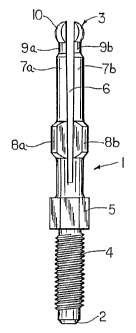Some of the information on this Web page has been provided by external sources. The Government of Canada is not responsible for the accuracy, reliability or currency of the information supplied by external sources. Users wishing to rely upon this information should consult directly with the source of the information. Content provided by external sources is not subject to official languages, privacy and accessibility requirements.
Any discrepancies in the text and image of the Claims and Abstract are due to differing posting times. Text of the Claims and Abstract are posted:
| (12) Patent: | (11) CA 2216398 |
|---|---|
| (54) English Title: | ELECTRICAL CONNECTOR FOR ATTACHMENT TO A MEDICAL DEVICE |
| (54) French Title: | RACCORD ELECTRIQUE POUR RACCORDEMENT A UN DISPOSITIF MEDICAL |
| Status: | Deemed expired |
| (51) International Patent Classification (IPC): |
|
|---|---|
| (72) Inventors : |
|
| (73) Owners : |
|
| (71) Applicants : |
|
| (74) Agent: | SMART & BIGGAR |
| (74) Associate agent: | |
| (45) Issued: | 2005-07-19 |
| (86) PCT Filing Date: | 1996-04-18 |
| (87) Open to Public Inspection: | 1996-10-24 |
| Examination requested: | 2003-03-10 |
| Availability of licence: | N/A |
| (25) Language of filing: | English |
| Patent Cooperation Treaty (PCT): | Yes |
|---|---|
| (86) PCT Filing Number: | PCT/US1996/005366 |
| (87) International Publication Number: | WO1996/033526 |
| (85) National Entry: | 1997-09-24 |
| (30) Application Priority Data: | ||||||
|---|---|---|---|---|---|---|
|
An electrical connector (1) for attachment to a medical device. The connector
includes a
shaft of electrically conductive material having a proximal end (2) and a
distal end (3). Screw
threads (4) on the proximal end attach the connector (1) to the device. A
longitudinally extending
slot (6) extends from the distal end and forms two legs (7a) and (7b). A pair
of shoulders (8a)
and (8b) extend from the middle of the connector. The shoulders are adapted to
engage internal
walls of one type of female conector. A circumferentially extending recess
(9a) and (9b) is
disposed adjacent the distal end. The recess forms a head disposed distally of
the connector.
The recess is adapted to engage a ring disposed within another type of female
socket. The legs
are displaceable such that they provide spring engagement of the connector
within the female
connector by either the circumferentially extending recess or by the
shoulders.
L'invention porte sur un raccord électrique (1) destiné à être raccordé à un dispositif médical. Ce raccord comporte une tige constituée d'un matériau conducteur ayant une extrémité proximale (2) et une extrémité distale (3). Des filetages de vis (4) sur l'extrémité proximale rattachent le raccord (1) au dispositif. Une rainure longitudinale (6) part de l'extrémité distale et définit deux branches (7a) et (7b). Une paire d'épaulements (8a) et (8b) part du milieu du raccord. Ces épaulements sont conçus pour venir en contact avec des parois intérieures d'un type de raccord femelle. Un évidement de forme circulaire (9a) et (9b), adjacent à l'extrémité distale, forme une tête située à l'extrémité distale du raccord. Cet évidement est conçu pour entrer en contact avec un anneau situé dans un autre type de douille femelle. Les branches peuvent se déplacer de telle sorte qu'un accouplement élastique du raccord dans le raccord femelle soit assuré, soit par l'évidement de forme circulaire, soit par les épaulements.
Note: Claims are shown in the official language in which they were submitted.
Note: Descriptions are shown in the official language in which they were submitted.

For a clearer understanding of the status of the application/patent presented on this page, the site Disclaimer , as well as the definitions for Patent , Administrative Status , Maintenance Fee and Payment History should be consulted.
| Title | Date |
|---|---|
| Forecasted Issue Date | 2005-07-19 |
| (86) PCT Filing Date | 1996-04-18 |
| (87) PCT Publication Date | 1996-10-24 |
| (85) National Entry | 1997-09-24 |
| Examination Requested | 2003-03-10 |
| (45) Issued | 2005-07-19 |
| Deemed Expired | 2010-04-19 |
There is no abandonment history.
Note: Records showing the ownership history in alphabetical order.
| Current Owners on Record |
|---|
| BOSTON SCIENTIFIC LIMITED |
| Past Owners on Record |
|---|
| BOSTON SCIENTIFIC CORPORATION |
| HACKER, RANDALL L. |
| HAWKINS, H. GENE |
| TESTA, VINCENT J. |